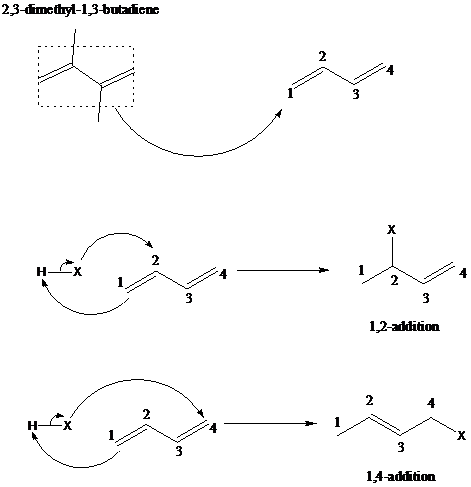
Concept explainers
Interpretation:
The reagents required to convert 2,3-dimethyl-1,3-butadiene to the given products are to be provided.
Concept introduction:
舧 Electrophiles are electron-deficient species, which has positive or partially positive charge. Lewis acids are electrophiles, which accept electron pair.
舧 Nucleophiles are electron-rich species, which has negative or partially negative charge. Lewis bases are nucleophiles, which donate electron pair.
舧 Free radical is an atom, molecule, or ion that has an unpaired electron, which makes it highly chemically reactive.
舧 Substitution reaction: A reaction in which one of the hydrogen atoms of a hydrocarbon or a
舧 Elimination reaction: A reaction in which two substituent groups are detached and a double bond is formed is called elimination reaction.
舧 Addition reaction: It is the reaction in which unsaturated bonds are converted to saturated molecules by the addition of molecules.
舧 The reaction in which there is addition of hydrogen molecule is called hydrogenation reaction.
舧
舧 Hydrogenation with platinum as a catalyst is used to convert unsaturated carbohydrates to saturated hydrocarbons
舧 Oxidation of
舧 Ozonolysis helps convert the carbon–carbon double bonds to carbon–oxygen double bond (carbonyl compounds).
舧 Dimethyl sulfide is used as a reducing agent that decomposes the intermediate formed into the carbonyl group.
舧 Alkenes react with bromine and form alkyl dihalides. The product stereochemistry is dependent on the stereochemistry of the reactant alkene.
舧 The 1,2 – addition of hydrohalogenation (HX) to a diene is the addition of hydrogen to the carbon designated as 1 and halogen to the carbon designated as 2. But the positions of carbons as 1 and 2 are not according to the IUPAC numbering of the molecule but as a conjugated diene. The mechanism is similar with 1,4-addition.
舧 The mechanism of 1,2 addition and 1,4-addition of hydrohalogenation is given below:

Want to see the full answer?
Check out a sample textbook solution
Chapter 13 Solutions
Organic Chemistry
- Provide the reagents and solvents (where appropriate) needed to bring about the following transformations. (a) CI (b)arrow_forwardWrite the structure of the major organic product formed in the reaction of each of the following with hydrogen bromide in the absence of peroxides and in their presence. (a) 1-Pentene (b) 2-Methyl-2-butene (c) 1-Methylcyclohexenearrow_forwardDraw a structural formula for the alcohol formed by treating each alkene with borane in tetrahydrofuran (THF) followed by hydrogen peroxide in aqueous sodium hydroxide, and specify stereochemistry where appropriate. (a) (d) (b) (e) (c)arrow_forward
- (a) Cyclohexa-1,3-diene can be converted into a tetrasubstituted haloalkane when reacted with bromine in ether. Write a balanced chemical equation for the reaction that occurs and state the expected observation. (b) Compound A and B are alkenes with the same molecular formula C5H10. Compound A is a branched-chain alkene while compound B is a straight-chain alkene. The reaction between compound A with hydrogen bromide produces major product C which is optically active. (i) Draw TWO (2) possible structures for compound B. (ii) Outline the mechanism for the reaction between compound A with hydrogen bromide to form major product C. (iii) Name the product formed when compound A undergoes bromination reaction.arrow_forwardGive the structure, exclusive of stereochemistry, of the principal organic product formed on reaction of 2,3-dimethyl-1,3-butadiene with each of the following:(a) 2 mol H2, platinum catalyst(b) 1 mol HCl (product of 1,2-addition)(c) 1 mol HCl (product of 1,4-addition)(d) 1 mol Br2 (product of 1,2-addition)(e) 1 mol Br2 (product of 1,4-addition)(f) 2 mol Br2arrow_forwardUsing cyclooctyne as your starting material, show how you would synthesize the following compounds. (Once you haveshown how to synthesize a compound, you may use it as the starting material in any later parts of this problem.)(a) cis-cyclooctene (b) cyclooctane (c) trans-1,2-dibromocyclooctanearrow_forward
- Develop syntheses for the following compounds. As starting materials, you may use cyclopentanol, alcohols containing no more than four carbon atoms, and any common reagents and solvents. (a) trans-cyclopentane-1,2-diol (b) 1-chloro-1-ethylcyclopentanearrow_forwardWrite structural formulas for the products that form when 1-butene reacts with each of the following reagents: (a) HI (b) H2, Pt (c) Dilute H2SO4, warm (d) Cold concentrated H2SO4 (e) Cold concentrated H2SO4, then H2O and heat (f) HBr (g) Br2 in CCl4 (h) Br2 in H2O (i) HCl (j) O3, then Me2S (k) OsO4, then NaHSO3/H2O (l) KMnO4, OH-, heat, then H3O+ (m) Hg(OAc)2 in THF and H2O, then NaBH4, OH- (n) BH3:THF, then H2O2, OH-arrow_forwardStarting from bromoethane, the formation of which of the following compound requires more than one step of reaction? 2 (a) Methoxyethane (b) Ethanol (c) Ethanoic acid (d) Ethenearrow_forward
- a) When (Z)-3-methylhex-3-ene undergoes hydroboration–oxidation, two isomeric products are formed. Give their structures, and label each asymmetric carbon atom as (R) or (S). What is the relationship between these isomers?arrow_forwardCompound D undergoes a reaction with hydrogen bromide, HBr to produce 2-bromobutane. D exists as cis-trans isomers and decolourises bromine solution in methylene chloride, CH2Cl2. (i) Draw and name the structure of compound D. (ii) Draw two (2) constitutional isomers of compound D.arrow_forwardUsing cyclooctyne as your starting material, show how you would synthesize the following compounds. (Once you haveshown how to synthesize a compound, you may use it as the starting material in any later parts of this problem.)(a) cis-cyclooctene (b) cyclooctane (c) trans-1,2-dibromocyclooctane(d) cyclooctanone (e) 1,1-dibromocyclooctane (f) 3-bromocyclooctene(g) cyclooctane-1,2-dionearrow_forward
 ChemistryChemistryISBN:9781305957404Author:Steven S. Zumdahl, Susan A. Zumdahl, Donald J. DeCostePublisher:Cengage Learning
ChemistryChemistryISBN:9781305957404Author:Steven S. Zumdahl, Susan A. Zumdahl, Donald J. DeCostePublisher:Cengage Learning ChemistryChemistryISBN:9781259911156Author:Raymond Chang Dr., Jason Overby ProfessorPublisher:McGraw-Hill Education
ChemistryChemistryISBN:9781259911156Author:Raymond Chang Dr., Jason Overby ProfessorPublisher:McGraw-Hill Education Principles of Instrumental AnalysisChemistryISBN:9781305577213Author:Douglas A. Skoog, F. James Holler, Stanley R. CrouchPublisher:Cengage Learning
Principles of Instrumental AnalysisChemistryISBN:9781305577213Author:Douglas A. Skoog, F. James Holler, Stanley R. CrouchPublisher:Cengage Learning Organic ChemistryChemistryISBN:9780078021558Author:Janice Gorzynski Smith Dr.Publisher:McGraw-Hill Education
Organic ChemistryChemistryISBN:9780078021558Author:Janice Gorzynski Smith Dr.Publisher:McGraw-Hill Education Chemistry: Principles and ReactionsChemistryISBN:9781305079373Author:William L. Masterton, Cecile N. HurleyPublisher:Cengage Learning
Chemistry: Principles and ReactionsChemistryISBN:9781305079373Author:William L. Masterton, Cecile N. HurleyPublisher:Cengage Learning Elementary Principles of Chemical Processes, Bind...ChemistryISBN:9781118431221Author:Richard M. Felder, Ronald W. Rousseau, Lisa G. BullardPublisher:WILEY
Elementary Principles of Chemical Processes, Bind...ChemistryISBN:9781118431221Author:Richard M. Felder, Ronald W. Rousseau, Lisa G. BullardPublisher:WILEY





